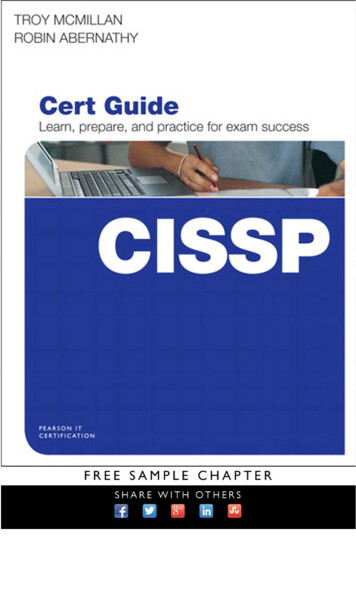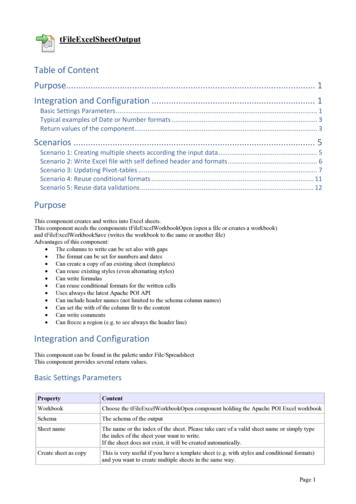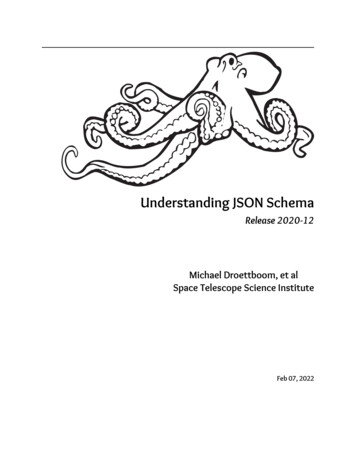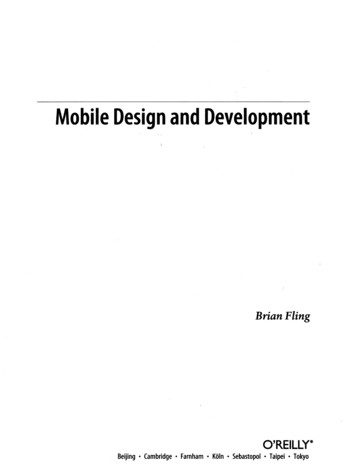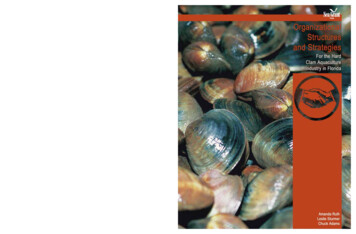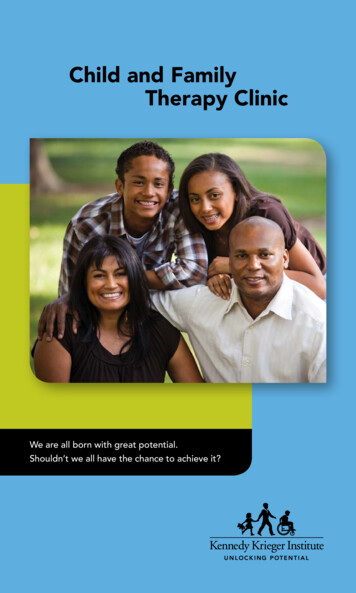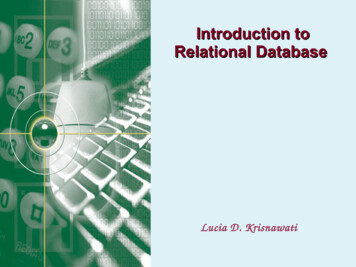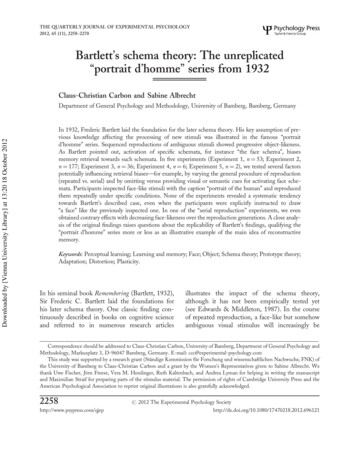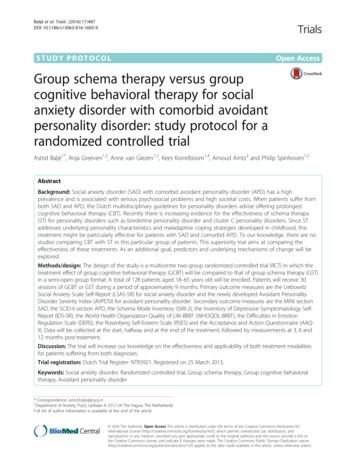
Transcription
Baljé et al. Trials (2016) 17:487DOI 10.1186/s13063-016-1605-9STUDY PROTOCOLOpen AccessGroup schema therapy versus groupcognitive behavioral therapy for socialanxiety disorder with comorbid avoidantpersonality disorder: study protocol for arandomized controlled trialAstrid Baljé1*, Anja Greeven1,2, Anne van Giezen1,2, Kees Korrelboom1,4, Arnoud Arntz3 and Philip Spinhoven1,2AbstractBackground: Social anxiety disorder (SAD) with comorbid avoidant personality disorder (APD) has a highprevalence and is associated with serious psychosocial problems and high societal costs. When patients suffer fromboth SAD and APD, the Dutch multidisciplinary guidelines for personality disorders advise offering prolongedcognitive behavioral therapy (CBT). Recently there is increasing evidence for the effectiveness of schema therapy(ST) for personality disorders such as borderline personality disorder and cluster C personality disorders. Since STaddresses underlying personality characteristics and maladaptive coping strategies developed in childhood, thistreatment might be particularly effective for patients with SAD and comorbid APD. To our knowledge, there are nostudies comparing CBT with ST in this particular group of patients. This superiority trial aims at comparing theeffectiveness of these treatments. As an additional goal, predictors and underlying mechanisms of change will beexplored.Methods/design: The design of the study is a multicentre two-group randomized controlled trial (RCT) in which thetreatment effect of group cognitive behavioral therapy (GCBT) will be compared to that of group schema therapy (GST)in a semi-open group format. A total of 128 patients aged 18–65 years old will be enrolled. Patients will receive 30sessions of GCBT or GST during a period of approximately 9 months. Primary outcome measures are the LiebowitzSocial Anxiety Scale Self-Report (LSAS-SR) for social anxiety disorder and the newly developed Avoidant PersonalityDisorder Severity Index (AVPDSI) for avoidant personality disorder. Secondary outcome measures are the MINI sectionSAD, the SCID-II section APD, the Schema Mode Inventory (SMI-2), the Inventory of Depressive Symptomatology SelfReport (IDS-SR), the World Health Organization Quality of Life-BREF (WHOQOL-BREF), the Difficulties in EmotionRegulation Scale (DERS), the Rosenberg Self-Esteem Scale (RSES) and the Acceptance and Action Questionnaire (AAQII). Data will be collected at the start, halfway and at the end of the treatment, followed by measurements at 3, 6 and12 months post-treatment.Discussion: The trial will increase our knowledge on the effectiveness and applicability of both treatment modalitiesfor patients suffering from both diagnoses.Trial registration: Dutch Trial Register: NTR3921. Registered on 25 March 2013.Keywords: Social anxiety disorder, Randomized controlled trial, Group schema therapy, Group cognitive behavioraltherapy, Avoidant personality disorder* Correspondence: astrid.balje@psyq.nl1Department of Anxiety, PsyQ, Lijnbaan 4, 2512 VA The Hague, The NetherlandsFull list of author information is available at the end of the article 2016 The Author(s). Open Access This article is distributed under the terms of the Creative Commons Attribution 4.0International License (http://creativecommons.org/licenses/by/4.0/), which permits unrestricted use, distribution, andreproduction in any medium, provided you give appropriate credit to the original author(s) and the source, provide a link tothe Creative Commons license, and indicate if changes were made. The Creative Commons Public Domain Dedication o/1.0/) applies to the data made available in this article, unless otherwise stated.
Baljé et al. Trials (2016) 17:487BackgroundBeginning with the Diagnostic and Statistical Manual ofMental Disorders (DSM)-III [1] and continuing in DSM-IV[2], individuals whose fears are manifest in most social situations are assigned to the generalized subtype of social anxiety disorder (SAD), while individuals whose fears are morecircumscribed are grouped together as a separate category,referred to as non-generalized social anxiety disorder. Sincethe introduction of the generalized subtype, there is a controversy about the differences with avoidant personality disorder (APD) [3]. While some researchers emphasize thatAPD is a serious form of generalized SAD [4, 5], a growingnumber of studies indicate that there is a qualitative difference between the two disorders. Shortcomings in establishing interpersonal relationships and severe feelings ofinferiority are seen as cardinal features of APD [3, 6, 7].To preserve continuity with clinical practice, the categorical diagnoses and criteria for personality disorders inthe DSM-5 are kept the same. An alternative dimensionalmodel is added in which, besides limitations in (inter)personal functioning, specific maladaptive traits pertaining tothe dimensions of ‘detachment’ and ‘negative affectivity’characterize persons with APD. Detachment is reflected inmaladaptive traits such as withdrawal, anhedonia and intimacy avoidance, while anxiousness and worry in relationto social situations characterize these patients with respectto negative affectivity [8]. Furthermore, on the basis ofempirical findings, it has been suggested that avoidance isa dominant coping strategy not only in social but also innon-social situations in APD [9–11].APD is associated with high societal costs due to frequentuse of somatic and mental health care, a high risk for developing other mental disorders and suboptimal professionalfunctioning. Furthermore, patients report a low quality oflife, and for family members, having a relative with a diagnosis of APD is often a considerable burden [12].In clinical practice, there is no consensus about whichtreatment is indicated for patients with diagnoses ofboth SAD and APD. In the Netherlands the multidisciplinary guidelines recommend offering prolonged cognitive behavioral therapy (CBT) in the case of SAD withcomorbid APD [13].A small number of effectiveness studies have shownthat CBT and pharmacological interventions are effectivefor patients with SAD and comorbid APD [14, 15]. Research among a sample of patients with social anxietyand patients with social anxiety and comorbid APDshowed that APD was not predictive of CBT treatmentoutcome, and that several subjects who received a diagnosis of APD before treatment no longer met criteria forAPD after treatment [16]. CBT in group format is approximately as effective as individual CBT [17].Furthermore, there is growing evidence that schema therapy (ST) is an effective treatment for patients with APDPage 2 of 13[18, 19]. Research has shown that APD is associated withemotional neglect and abuse in the past [20, 21]. When thenormal, healthy developmental needs of childhood are notmet, maladaptive schemas develop. Activation of theseschemas can trigger an emotional, cognitive and behavioralstate, which in ST is called a ‘schema mode’ [22]. APD canbe well conceptualized in terms of schema modes, with detached and avoidant protector modes as prominent copingmodes, lonely child and abandoned/abused child mode asprominent child modes and punitive parent mode asprominent internalized parent mode [10, 23]. Within STdifferent techniques are applied, including experientialtechniques such as imagery rescripting and mode roleplays, that explicitly address dysfunctional coping modes. Anew development is group ST (GST), where specificmethods and techniques are applied to use the groupprocess in order to facilitate the process of change [22, 24].Because of the promising results of ST, we designed asuperiority trial with the primary objective of investigatingthe effectiveness of group schema therapy (GST) compared to prolonged group CBT (GCBT) for patients withsocial anxiety disorder (SAD) and comorbid avoidant personality disorder (APD). More specifically the followingresearch question has been formulated: What is the effectof prolonged GCBT compared with GST for SAD withAPD? Since people included in this trial will be diagnosedwith both SAD and APD, improvements can be realizedin two different domains: with respect to SAD symptomsand with respect to severity of APD traits. Therefore, theresearch question can be more explicitly formulated in thefollowing questions: How do the effects of prolongedGCBT and GST compare for social anxiety disorder? andHow do the effects of prolonged GCBT and GST comparefor avoidant personality disorder?Investigating predictors, moderators and mediators oftreatment can add valuable knowledge to our understanding of for whom, under what conditions and how treatments work, thus generating valuable hypotheses for futureresearch [25]. Therefore, this study will, as a secondary objective, look at possible predictors, moderators and mediators of changes on the primary outcome measures. Asputative mediators, emotion regulation, self-esteem andschema mode manifestations will be repeatedly measuredand associated with outcome. To detect possible predictorsand moderators of treatment, the (differential) predictivevalue of different baseline measures for changes on the primary outcome measures will be explored.Methods/designDesignThe design of the study will be a 30-session (on a weeklybasis), two-group (GST, GCBT) randomized controlledclinical trial with repeated measurements at baseline (T0),mid-test (T1), post-test (T2) and at 3 months follow-up
Baljé et al. Trials (2016) 17:487(T3), half-year follow-up (T4) and 1-year follow-up (T5).Assessment will include diagnostic interviews, symptomquestionnaires and quality of life, self-esteem, schemarelated and emotion regulation measures. See Fig. 1 (Flowchart of enrolment, intervention and assessments) andAdditional file 1 (Standard Protocol Items: Recommendations for Interventional Trials (SPIRIT) flow diagram) foran overview of the study; the SPIRIT checklist is presentedin Additional file 2. Diagnostic interviews are based on theDSM-IV classification system [2], since the DSM-5 [8] wasnot yet available during the developmental phase of thisstudy and there was an absence of diagnostic instrumentsbased on the DSM-5 at the start of the study.After conclusion of the experimental part of the study(3 months after the last session of the treatment), patients will enter a naturalistic follow-up period in whichthey are allowed to seek help the way they would normally do when they feel in need for further treatment.The study will be performed at two sites of PsyQ, a largeambulatory mental health organization in the Netherlands.Two departments of anxiety disorders of PsyQ willPage 3 of 13participate, one located in The Hague and the other in Rotterdam. Other departments, for instance, the departmentsof depression or personality disorders, in the regions of TheHague and Rotterdam will be informed of the study andwill be asked to refer eligible patients. If necessary to guarantee a sufficient inclusion of eligible patients, more treatment centres will be approached for study participation.Population/sample sizeBefore the start of the randomized controlled trial(RCT), a chart review showed that both the PsyQ location of Rotterdam and the PsyQ location of The Haguehave an annual patient flow of 40 patients with bothSAD as well as a comorbid APD. This represents anoverall yearly N of 80, of which it is expected that approximately 90 % (N 72) will be included. This meansthat every year in each department 36 patients can berandomized over the two conditions. CBT and ST groupsconsist of a maximum of 9 patients.We know that CBT has a large effect on SAD comparedto waitlist and a small to moderate effect compared to placebo [15]. With respect to ST, in a randomized trial comparing ST, clarification therapy and treatment as usual(TAU), Bamelis et al. [19] found an odds ratio between STand TAU in recovery from PD diagnosis in the 3–4 range(depending on the specific (sensitivity) analysis), which isequivalent to Cohen’s d .60–.76 [26]. Though a substantial number of patients in the ST condition had a diagnosisof APD, only a small minority of patients received CBT asTAU. No studies are available directly comparing ST withCBT with respect to APD with comorbid SAD. We therefore designed our RCT as a superiority trial with enoughstatistical power to detect a difference in outcome between treatments (if present) with a medium effect size(Cohen’s d .5). We chose this minimum difference because such a difference is important based on a patient’sperspective or clinical knowledge. Expecting larger differences in outcome does not seem realistic and might resultin an underpowered study, while detecting smaller differences is of less relevance for clinical practice. Thus, we designed our study to detect a medium effect size (0.50)with a power of 80 % and a two-tailed alpha set at 0.05 onthe primary outcome measures, severity of social anxiety(Liebowitz Social Anxiety Scale Self-Report, LSAS-SR)and severity of avoidant personality disorder (AvoidantPersonality Disorder Severity Index, AVPDSI). Thisimplies that 64 patients per study group and in total 128patients are needed for the present project.Inclusion and exclusion criteriaFig. 1 Flow chart of enrolment, intervention and assessmentsPatients aged between 18 and 65 with primary diagnoses ofSAD on Axis I and comorbid APD on Axis II will be included in the study. Primary diagnosis is defined as thediagnosis on which treatment should focus at first instance
Baljé et al. Trials (2016) 17:487according to both patient and clinical staff. Other inclusioncriteria are willingness, motivation and practical ability toattend 30 sessions of group therapy and to refrain fromtreatment or counselling outside the context of the presenttrial. The use of antidepressant medication or benzodiazepine will be permitted, under the condition that the medication dose has been stable for at least 3 months beforeinclusion and patients are willing not to raise the dosage ofthe medication during the active phase of the trial. Furthermore, patients must be willing to complete homeworkassignments between sessions and must sign writteninformed consent to participate in the study.Exclusion criteria are suicidality and the presence ofpsychotic or bipolar symptoms, because these conditionscould interfere with the measurement and treatment procedures and suggest an immediate need for alternative interventions. Another exclusion criterion is an Axis Idiagnosis of substance abuse or dependence which needs,according to the clinical staff, detoxification (after successful detoxification patients can participate). Moreover, patients with a primary Axis II diagnosis of a borderline,antisocial, schizoid, schizotypal personality disorder willbe excluded, because they need highly specialized treatment. Patients in whom there is a suspicion of an autismspectrum disorder (based on a sum score on the AutismSpectrum Quotient (AQ) higher than 32) [27], who havean IQ less than 80 (in case of suspicion an intelligence testis taken), and problems with the Dutch language (talking,reading, writing) will also be excluded.Inclusion and exclusion procedure and randomizationPatients who are registered for treatment at the department of anxiety disorders will be screened on the presence of Axis I disorders by the intake clinician. Eligiblepatients are patients diagnosed with SAD, or in the caseof more than one Axis I diagnosis (e.g. panic disorder ordepressive disorder), patients for whom social anxietyshould be the principal focus of treatment, according toboth patient and clinical staff. At first instance these patients will receive concise information about the studyby the intake clinician. At PsyQ The Hague they willthen receive a leaflet containing information about thestudy, which is sent by mail after a research assistant hasinformed the patient by phone. At PsyQ Rotterdam theleaflet is handed over at the first appointment by the intake clinician or during a second appointment in whichthe patient is given treatment advice. Patients of that location will be contacted by the research staff after theAxis II diagnosis of APD is established.Eligible patients are invited for a diagnostic interview —consisting of the Structured Clinical Interview for DSMIV Axis II Personality Disorders (SCID-II) — to determinethe presence of Axis II disorders and other inclusion andexclusion criteria. Beforehand patients receive the AQ andPage 4 of 13the pre-screener of the SCID-II. During the SCID-II interview all cluster C personality disorders are fully investigated. All confirmatively answered and all unansweredquestions on the pre-screener will also be assessed withthe SCID-II interview. If the personality trait is confirmedand the amount of confirmed traits pertaining to a certainpersonality disorder exceeds three, all traits pertaining tothat personality disorder will be assessed with the SCID-IIinterview. Besides scores on the pre-screener, clinicaljudgement can also be a reason to fully examine a certainpersonality disorder. In addition to SCID-II, the MiniInternational Neuropsychiatric Interview (MINI), sectionsocial anxiety, is also administered. The MINI interview ispart of the intake procedure of both anxiety departmentsof PsyQ in addition to a general clinical interview. Someof the patients entering this study will have recently signedup for treatment and will have completed this procedure,but referral by other departments or during ongoing treatment is also possible. It was therefore decided to add theSAD section of the MINI to ensure that patients includedmeet the inclusion criteria of both SAD and APD.During the examination, patients will receive additional verbal and extensive written information aboutthe study with respect to both treatment conditions andconsequences of participating. After conclusion of theSCID-II administration, patients will be either informeddirectly or receive a follow-up appointment to discussthe findings of the interview. Patients will have 2 weeksto consider participation, after which they will becontacted by a research assistant. Written informed consent will be obtained from patients who are willing toparticipate, and they will be asked to fill in the baselineassessment comprising different self-report questionnaires. To be able to assess the frequency and severity ofmanifestations of APD, a semi-structured interview wasdeveloped: the AVPDSI. The AVPDSI interview is administered by phone by a trained psychologist or atrained master student in clinical psychology who fulfilsa traineeship at the PsyQ anxiety department.After a final file check of inclusion and exclusion criteriabased on the patient file and after all baseline measures arecompleted, a research assistant will randomize the patientsto the GCBT or GST condition using a computergenerated list (https://www.random.org/lists/). Patients willbe randomized in pairs or multiples of pairs. In case of uneven dropout from treatments, a weighted randomizationwill be done to prevent one of the groups from becomingtoo small. For both locations this will be done separately.The main researchers and other outcome adjudicatorsare blind to group assignment to protect integrity ofdata collection and analysis. Because it is impossible fora therapist to offer and for a patient to receive therapywithout being aware of the techniques they are using orreceiving, therapists and patients are not blind. Finally,
Baljé et al. Trials (2016) 17:487because data collectors are also employed as therapistsin the anxiety departments of the participating sites, theyare able to access patient records. Therefore, data collection of clinician-administered measures cannot beblinded. To reduce the risk of biased data collection,therapists involved in delivering either the GCBT orGST are not involved in data collection.InterventionsDifferent guidelines recommend CBT for treatment ofSAD [28–30]. CBT is seen as the gold standard for SADwith respect to non-pharmacological treatment, and gainsachieved with CBT seem to persist longer than thoseachieved with pharmacotherapy [29]. Guidelines differwith respect to the advised treatment format (individualor group therapy). The Canadian guidelines do not express any preference, NICE guidelines advise individualCBT and Dutch guidelines recommend group CBT [28–30]. None of these guidelines advises on the treatment ofSAD and comorbid APD. With respect to APD, guidelinesare scarce. Dutch multidisciplinary guidelines recommendgroup behavioral treatment for patients with APD. Theyspecify that in case of comorbidity of SAD and APD, CBTis seen as an adequate treatment option, although prolonged treatment is necessary to realize comparablefavourable outcomes as for SAD only [13].GCBT is a regular treatment option and fits neatly inthe health care program offered at the RCT participatingdepartments of anxiety disorders. GST will be a newtreatment, but will be performed by skilled and experienced therapists. Both treatments were piloted in advance to enable therapists to become acquainted withthe treatment protocol and the semi-open group format.In the ST condition therapists had no former experiencewith ST in a group format; therefore, this treatment modality was permitted an 8 months longer pilot period. InThe Hague the pilot period for GST was 18 months andfor GCBT 10 months. In Rotterdam the pilot period forGST took 32 months and for GCBT 24 months, this wasdue to a major reorganisation.For patients of both GST and GCBT, treatment comprises of 30 weekly group sessions of 90 minutes, preceded by 2 introductory individual sessions of45 minutes. In addition to the group treatment, limitedindividual time with the therapist is permitted with amaximum of 180 minutes. Individual contact can takeplace in person or by phone or e-mail and can be initiated by either patient or therapist, for instance if urgentpersonal matters come up or if the therapist fears dropout and wants to discuss possible obstacles for the patient. Sessions will be audiotaped to assess protocoladherence. For both GST and GCBT, customized ratingforms will be developed and a random selection of tapesPage 5 of 13will be listened to in order to evaluate to what extenttherapists adhere to the protocol.Group schema therapy (GST)GST is a recently developed treatment for personalitydisorders. GST is shorter, more directive, confrontational and integrative — using experiential, cognitiveand behavioral techniques, addressing childhood andpresent — than traditional psychodynamic psychotherapies for personality disorders. Schemas can be described as psychological constructs that include beliefsthat we have about ourselves, the world and otherpeople, which result from interactions of innate temperament and early environmental factors, notablytrauma and unmet core childhood needs. When maladaptive schemas are triggered, specific states occur, asthe result of the combination of activated schema(s)and type of coping, that can be described as schemamodes. Schema modes are central in GST. Schemamodes often had an adaptive role in childhood (e.g. interms of survival in an adverse situation), but becomemaladaptive and limiting in adulthood. GST aims at reducing the use of dysfunctional coping modes, healingthe maladaptive child modes, banishing the internalizedparent modes and strengthening the adaptive modes(healthy adult mode and happy child mode). The ultimate goal of GST is to enable patients to get their emotional needs met, including gaining autonomy andforming healthy social relationships. In GST the groupis used as an analogue for the family of origin with theother group members as ’siblings’ and the therapists as’parents’. Group processes can be used to create corrective emotional experiences and to reduce maladaptive coping modes [24].For this study, a 30-session treatment protocol of 90minute weekly sessions over 9 months was developed.The treatment protocol is naturalistic in the sense that,apart from the framework directing treatment focusthroughout sessions, therapists do not have a session-tosession detailed treatment manual. The structure of thegroup will be semi-open, and every 10 weeks new patients can enter an ongoing group. Before a patient enters the group, two individual meetings will be plannedto provide some information about the content and theprocess of GST, to discuss briefly the results of theSchema Mode Inventory (SMI) and to formulate a caseconceptualization in schema mode terms in collaboration with the patient.Participants are encouraged to engage in homeworkbetween sessions to gain corrective experiences in linewith individual needs. Thus, homework does not focuson exposure to social situations that are feared, but onfinding ways to better meet one’s needs. Each course willbe provided by two experienced therapists who received
Baljé et al. Trials (2016) 17:487formal GST training by Farrell and Shaw. They will receive monthly supervision (1.5–2 hours) by Farrell andShaw using Skype.Group cognitive behavioral therapy (GCBT)GCBT will follow a prolonged version of the wellinvestigated protocol of Heimberg and colleagues of grouptherapy for SAD [31–33] in combination with some newinsights in the working mechanisms of exposure in vivo[34]. GCBT will mainly consist of simulated exposures tofeared situations in-session, cognitive restucturing and invivo exposure to feared social situations between sessions.Just as in the GST, the format of the group will be semiopen, allowing new patients to enter the group every10 weeks, and the group treatment of 30 weekly sessions ispreceded by 2 individual sessions.The individual sessions are aimed at facilitating the startof the group treatment. During these sessions informationabout the content of the therapy is provided and an individual case conceptualization is drawn. Emphasis will beplaced on the role of avoidance and safety-seeking behaviors in the maintenance of SAD. The basics of cognitive restructuring will be presented, and patients will be asked towrite down a list of feared situations which will be placedin a hierarchical sequence. Social anxiety will be consideredas a learned response to social situations incorporatinginteractive physiological, behavioral and cognitive features.Social anxiety disordered patients supposedly fear most social situations because of their expectancies to be humiliated or rejected by others or confrontations with their ownsupposed social inadequacies and failure. The main therapeutic target in GCBT is the disconfirmation of these dysfunctional expectancies. To a small extent one strives forthese disconfirmations using traditional cognitive procedures such as identification, intellectual challenging and(possibly) correcting of dysfunctional opinions. By far thelargest part of the CBT procedure of disconfirming suchexpectancies exists of exposure in vivo. Since the understanding of the working mechanisms of exposure in vivohas changed in recent years, the main target of exposure invivo is no longer habituation of the fear response. Nowadays it is believed that exposure in vivo sets off a processof inhibition in which the association of the conditionedstimulus (CS) (social situations) and the feared unconditioned stimulus (US) (humiliation) is inhibited by the forming of new associations around the CS, of which theassociation with ‘no-US’ (no rejection) is probably the mostimportant [34]. During group sessions and for homework,patients expose themselves deliberately to the social situations they fear in order to let new non-anxious associationsform and to experience in particular that the negative consequences they expected in advance did not become truein reality. Noticing the differences between the expectedand the actual outcomes of these confrontations is anPage 6 of 13important subject for therapeutic discussion after exposure. Therefore, the GCBT protocol is a mix of the wellproven approach of Heimberg and some new insights inthe mechanisms of exposure in vivo.Most group sessions will focus mainly on performancebased gradual and systematic exposure with elimination ofthe accompanying safety behaviors. Self-exposure to situations that resemble the exposure practiced in-session is prescribed as homework to further promote correction ofnegative expectancies. GCBT is highly structured, with eachsession following the same agenda including discussinghomework assignments, in-session performance-based exposure and assigning new homework. The group is used toprovide an immediate exposure setting while it offers thepossibility of vicarious learning from other group membersat the same time. The group is, however, mainly disorderspecific in a sense that the primary goal is reduction of social anxiety symptoms. In contrast to GST group processes,childhood experiences and experiential exercises will not beused to promote symptom reduction. Each course will beprovided by two experienced cognitive behavioral therapistswho have been trained in the specific GCBT protocol. During the trial the therapists will receive supervision every2 weeks (0.45 to 1 hour) by a licensed CBT supervisor.Dropout and follow-upIn case of emergencies (like severe increase of symptoms,suicidality) deviation from the protocol is allowed. Subjects can leave the study at any time for any reason if theywish to do so. The researcher can — in consultation withthe group therapists — also decide to withdraw a subjectfrom the study for urgent medical or psychological reasons. Reasons for dropout or withdrawal will be registered.Patients who withdraw from treatment will also be askedto complete follow-up assessments. As mentioned before,during the active treatment phase, participation in othertreatments, starting medication or raising the medicationdosage is not allowed. Also missing too many sessions isnot permitted (patients should at lea
Keywords: Social anxiety disorder, Randomized controlled trial, Group schema therapy, Group cognitive behavioral therapy, Avoidant personality disorder * Correspondence: astrid.balje@psyq.nl 1Department of Anxiety, PsyQ, Lijnbaan 4, 2512 VA The Hague, The Netherlands Full list of
